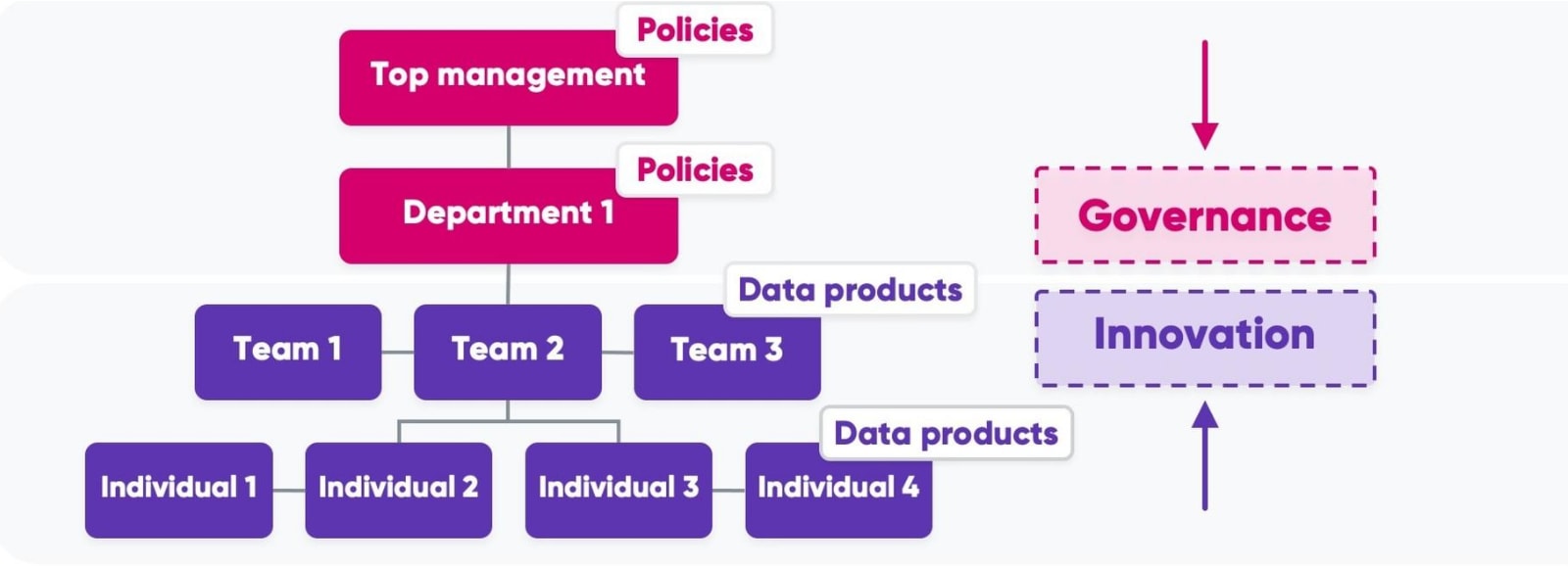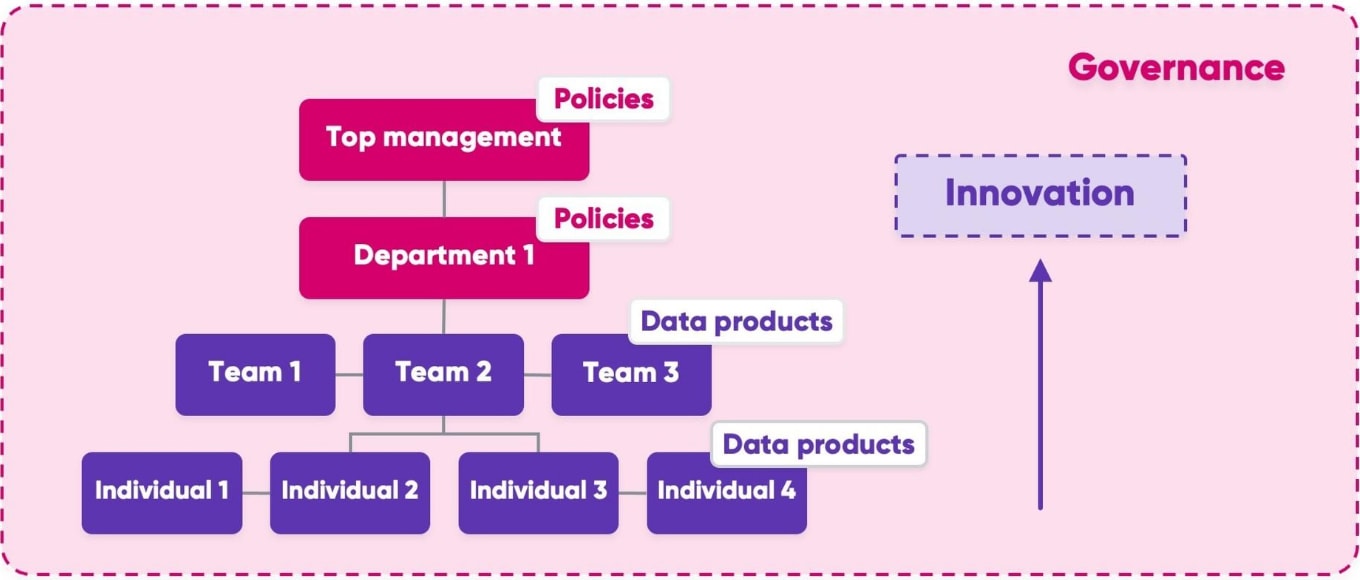We all wish we were superheroes, but if you think about it, our dreams are not far from the truth. Beyond brave professions like firemen and doctors, we often marvel at people's abilities in many different areas and call others marketing superheroes and engineering superstars. The same is true in the world of business and data.
The leaders in business teams are true superheroes that use data to create new products and services. All data people superheroes: the effort data stewards, data architects, and data engineers put in to maintain an organization's data integrity are worth nothing short of reverence.
However, sometimes superheroes fight. Fans of The Avengers remember the epic fight between Iron Man and Captain America. Sometimes, the same happens in organizations with superhero governance and business teams.
The time has come to restate this conflict and explore how a harmonious relationship between business and governed data access can lead to growth, competitive advantage, and agility.
Key takeaways of this article include:
- Data governance and innovation are often at odds, yet this conflict is counterproductive and harms the data quality and business outcomes.
- Data governance and business agility can achieve harmony with modern data management solutions.
- Best practices can achieve agility-focused data governance and promote collaboration and compliance.
Defining the conflict between business agility and data governance
Scale and speed are essential for any business to succeed. Business users are driven by a "power of now"—they expect timely, contextual, and comprehensive data instantaneously to use business intelligence as a decision-making tool. Unfortunately, we observe a conflict between the centralized way of doing governance and the bottom-up way of data innovation.
On the one hand, the data governance organization tries to ensure that their organizations deal with data is governed: it's secure, efficient, and reusable. CDOs, data architects, heads of data governance, data quality managers, and line of business managers try to implement best practices and frameworks for each. They try “do things in the right way.”
On the other hand, the people that drive the innovation: business people, data scientists, data analysts, and others see governance as an obstacle or something that's slowing them down. When they are transforming, integrating, cleansing data, or creating a data product to be used by BI tools, machine learning, or a digital application, they just want to use data.
The conflict between data governance and innovation defined: management wants governance and scalability; individuals want speed and getting results fast

Is there a disconnect if "agile" is the mantra of business teams and "governance" is the mantra of top and middle management?
To understand this, it's worth deconstructing the terms "business agility" and "governance." A deeper understanding of both reveals their harmony.
The role of data governance
What fire safety devices are to a house, data governance is to an organization.
An organization's data governance is a set of guidelines, policies, and rules that determine how its data is structured and managed. It is an essential component of any business strategy and regulatory compliance.
A more modern variation of data governance, which some call data enablement, is seen in ensuring that the right people have access to and can use the data at the right time and place while also ensuring data reliability, trustworthiness, and security.
A fundamental part of data governance is establishing specific policies and managing them. Proponents of agility insist that a company's most valuable resource—its data—should be available to everyone in a format they can use. Otherwise, the innovation would stagnate, and the competitive advantage would be lost.
Still, it takes just one disgruntled employee or even a well-meaning but mistake-prone employee to leak confidential information to anyone and everyone. When agility becomes a prerequisite for and a determinant of "competitive advantage," a leak of this nature would be tragic. To comply with compliance regulations, we need to install some guardrails.
Last but not least, having an effective data governance policy reduces the need to constantly firefight. With no more emergencies to deal with, organizations can streamline operations and concentrate on creating new value, being innovative and resourceful. When firefighting is no longer necessary, a company can treat and appreciate data as an asset.
In addition to ensuring basic data safety, good governance makes making data-driven decisions second nature. That way, data governance keeps an organization agile - even in an uncertain world.
CDOs are under pressure to support digital business outcomes, and the volume and velocity of data are rising. As a result, according to Gartner, data governance is no longer a matter of staying compliant with regulations - it is a crucial business capability.
What is business agility?
Business agility is an organizational process that helps businesses adjust quickly to external or internal market changes and adapt to customer demands. Agile businesses are more likely to thrive and keep their customers.
Business agility can be traced back to software development. Due to the complexity of development projects, the agile method helped to deal with changing requirements and uncertain outcomes. The development of the agile framework allowed adapting to constantly changing project environments.
Modern business teams want frictionless access to data to verify hypotheses and build new products and services. The faster they can iterate and test their hypotheses, the more they can experiment and find the right solution in the face of changing markets, business conditions, or customer preferences.
The importance of data management to business agility
97% of respondents from our 2022 State of Data Quality report say that their organizations consider data quality important. 83% of that same group say that data is vital for decision-making. This tells us that organizations are predominantly data-driven but want to use high-quality data.
The role of data management in business agility is massive. It enables the creation of reusable data products and lets virtually anyone with the proper permissions use them for their purposes.
The beauty of modern unified data management platforms is that they enable business agility without sacrificing data governance. By combining all essentials data management components such as metadata management, data quality, data master data management, data integration, and others, these platforms let users do everything they ever have to with data:
- Quickly find and understand it
- Cleanse and validate data
- Set up continuous monitoring of data quality
- Create golden records of data in any domain
- Transform data and use for analytics, machine learning, and other purposes
Modern data management also connects data professionals with business users by letting them collaborate on data governance initiatives and continuously improve their data. Let's explore how technology can remove this tension between data governance and business agility.
Achieving harmony between data governance and business agility
Agility and governance are fundamentally intertwined. But is it possible to avoid a trade-off between governance and centralization on the one hand and agility on the other?
The solution to foster data-driven innovation without compromising data governance is to make data governance omnipresent and non-blocking. “How do we do that exactly?” you might ask. We believe, at the moment, the answer has two parts:
- Automation
- Organizational best practices

Automation
The main goal of automation is to embed data governance into as many data processes as possible and automatically assign and enforce data governance policies. This requires a high degree of metadata management maturity as well as corresponding technology that can:
- Continuously maintain metadata freshness
- Classify data with minimal assistance from data stewards
- Use metadata to automate policy enforcement and data quality management processes
- Embed said policies and DQM processes into enterprise applications and data access points
Data fabric does that and more. The goal of the data fabric is not only automation of data governance but, more importantly, ensuring frictionless access to data.
If the data fabric seems like an unattainable holy grail, you can focus on automated metadata and data quality management.
Organizational best practices
Data mesh is becoming a popular framework for decentralized data management. However, you can devise a custom organizational structure that supports the notion of cross-functional teams focused on creating reusable data products.
The data mesh aims to create an organizational structure that will make creating data products as simple as possible. Besides, the data mesh places specific “rules of the games” for teams that enforce global data governance principles.
Combining these two data management blueprints, you can remove the tension between data governance and business agility.
Of course, you can also follow the best practices of modern data governance.
Best practices to achieve harmony between governance and agility that never get old
Whether the business is establishing data governance systems from scratch or making changes to existing ones, the following principles will ensure a sync between business agility and data governance.
1. Ensure data governance is aligned with business goals
Data governance projects often fail to match mission statements to business goals. Too often, data governance is seen as a function of the data department rather than a responsibility of the entire organization. However, unless business and IT leaders align their strategy and goal-setting, they risk focusing on tactics and metrics that don't reflect business objectives.
For example, the company may be analyzing metrics that measure data transformation ("X data points deduped, Y data points corrected") instead of metrics that measure actual customer experience or data quality.
Any business committed to its digital transformation goals around improving data-driven decision-making; any business that has invested or is planning to invest in data and analytics – should prioritize business-focused data governance for 2022 and beyond.
2. Balance the offensive and defensive use of data
Data governance must be redesigned in a data-driven business agility environment to provide value. The new capability must support
- Defensive use of data: assuring compliance to regulations, ethics, and risk minimization.
- Offensive use of data: supporting insight generation and integration with business needs and requirements,
Using this approach, organizations can incrementally create, manage, and leverage reusable data assets based on business strategy, agile planning, and regulatory guidelines.
3. Promote collaboration between data governance and business teams
Business and data governance teams must establish mutual understanding and respect based on a mutual understanding of the policies and objectives governing each area. Data governance should adopt the concept of business agility, and business development teams must be aware that data usage must ultimately comply with data governance policies. Business team members can also perform data stewardship tasks on a part-time basis.
Is your data governance enabling business agility?
Data is becoming more demanded and accessible to a broader audience within organizations. If you are a CDO or a data governance leader, it is time to examine your data strategy and make sure that data governance supports business agility in your organization.
Here at Ataccama, we offer a unified data management platform that enables business and data teams to collaborate on creating high-quality, reusable data products. If you're interested in automating data governance and data quality management and using data for accelerating business outcomes, send us a message to discuss your goals.
Want to understand data fabric or data mesh, level up your data management knowledge, and get a sneak peek of the latest Ataccama innovations? Attend Data People Summit.




